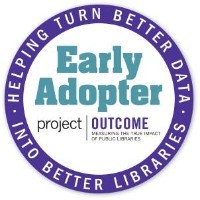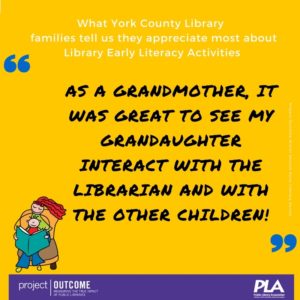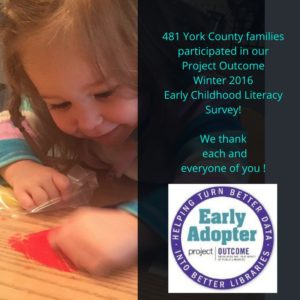 Submitted by Mina C. Edmondson,
Submitted by Mina C. Edmondson,
District Consultant, York County
York County Libraries was recently named a Project Outcome Early Adopter.
In the winter of 2016 York County Libraries conducted surveys of the parents and caregivers who attend Early Childhood Literacy Services and Programs at their libraries. The results of the surveys are included below.
York County Libraries has created a series of Facebook and Twitter posts highlighting the results of their survey, a few are attached. These posts included supporting evidence of the value of Early Literacy programs for children, quotes from the parents and caregivers who participated, as well as a shameless depiction of the District Consultants granddaughter playing at the library.
A hand out was also created to present to the families that participated, community members and library stakeholders. The flyer was also used to recruit new families to participate in the programs. A formal letter was provided to each library to present to their boards and funders. Project Outcome provides the survey tools, analysis and documentation on the subject needed to build the value of library Early Childhood Literacy activities. A follow up survey is being conducted this fall.
The public library is a fun, creative, safe space where parents and caregivers can bring their children to learn and interact with one another and in groups. Early childhood literacy services and programs range across a variety of activities, from reading to singing to playing. With parents and caregivers leading such busy lives, public libraries provide an opportunity for scheduled and structured one-on-one time with children, providing programs such as Storytime and Read, Play, Grow.
Engaging in early childhood literacy activities puts children ages 0-5 on a strong path to developing the critical thinking, vocabulary and language, problem solving, social, physical, and creative skills necessary to succeed later in life.
York County Libraries
Survey Work
York County Libraries staff distributed surveys to program participants to collect data and insights about how their early childhood literacy services and programs are supporting community needs. York County Library System surveyed patrons using the Project Outcome Early Childhood Literacy Services and Programs Survey, which measures services designed to improve early literacy and learning skills to prepare children ages 0-5 to succeed in school. A total of 481 survey responses were collected.
Results
Of the percentage of parents or caregivers surveyed who either agreed or strongly agreed that they or their children benefited from the service or program:
Pre Survey- January 2016
98% learned something that they can share with their children
92% felt more confident helping their children learn
93% intended to spend more time interacting with their children
94% were more aware of applicable resources and services provided by the library
Post Survey-April 2016
97% learned something that they can share with their children
94% felt more confident helping their children learn
97% intended to spend more time interacting with their children
97% were more aware of applicable resources and services provided by the library
Implications for Community Impact- as Provided by Project Outcome Researchers
Every Child Ready to Read (ALSC/PLA, 2011, 2nd ed.) defines the five key early literacy practices parents or caregivers should engage in with their children to promote reading readiness as talking, singing, reading, writing, and playing. Early childhood literacy services and programs should include planned activities for deep and continual learning that align with target stages of childhood development. (1)
- Public libraries promote parent and caregiver reading to children, which many studies point to as a key influence on early childhood development. A parent or caregiver’s techniques for reading to children have both short-term and long-term effects on language learning and literacy; research shows that shared book reading activities are an important way for children to learn about printed language such as vocabulary, letters, and text direction. (2)
- Playtime is essential to early childhood development and literacy. A University of Iowa study reports that 18-month-olds who play with diversely shaped objects learn new words twice as quickly as those who play with more similarly shaped objects. (3) In a 2007 study conducted by Seattle Children’s Research Institute, 1-1/2 to 2-1/2 year-old children who received blocks during the study scored 15% higher on a language assessment than those who received blocks after the study concluded. (4)
- Public libraries provide a free, safe space for community members to bring their children. Access to a safe environment is a major contributor to a child’s early literacy success. Characteristics of the environment in which a child reads and learns have an effect on the child’s engagement in reading. For example, a number of studies indicate that in settings that have varied books and play activities children read more and have improved literacy. (2)
- Most people in the United States consider libraries to be an important part of the education system. 85% of people in the United States think libraries and schools should work together to provide resources to children. 85% also say that libraries should provide free early literacy programs to help prepare children to attend school. Additionally, 78% think the libraries in their communities effectively promote reading. (5)
Project Outcome surveys were developed by PLA’s Performance Measurement Task Force (PMTF), which is comprised of a diverse group of public and state library leaders, consultants, data researchers, and analysts. The PMT F developed and pilot-tested the surveys in late 2014, carefully choosing the survey language to quantify the immediate perceived benefits from library programs, such as changes in knowledge, behavior, skills, or awareness. The surveys were designed to support libraries’ efforts to measure program outcomes and use the results to enhance strategic planning, manage resources more efficiently, and support advocacy messages. The results are intended to show the direction of change in the community, not rigorous statistical proof of change.
York County Libraries
Profile
Population of Legal Service Area: 434,972
Annual Operating Expenditures: 8,228,676
Number of Libraries: 14
FT E Staff: 154.62
Visits per Capita: 3.167
Annual Hours Open: 30,014
Sources
1 Nespeca,S. “The Importance of Play, Particularly Constructive Play, in Public Libraries “Association for Library Service to Children (2012). Accessed June 3, 2016. http://www.ala.org/alsc/sites/ala.org.alsc/files/content/Play_formatted.pdf
2 “Every Child Ready to Read, Literature Review,2010”, Accessed June 3, 2016. http://www.everychildreadytoread.org/project-history%09/literature-review-2010
3 “Exposure to More Diverse Objects Speeds Word Learning in Tots,”(Iowa University of Iowa News, 2010) Accessed Julne 3,2016. http://news-releases.uiowa.edu/2010/december/120610word-learning.html
4 “Playing with Blocks May Improve Language Development in Toddlers, New Study Finds,” (Seattle WA:Seattle Children’s Hospital , 2007). Accessed June 3, 2016. http://www.seattlechildrens.org/media/press-release/2007/10/002832/
5 Horrigan, John. “Libraries at the Crossroads: Pew Research Center, September 2015, Accessed June 3, 2016. http://www.pewinternet.org/2015/09/15/2015/Libraries-at-crossroads/.

